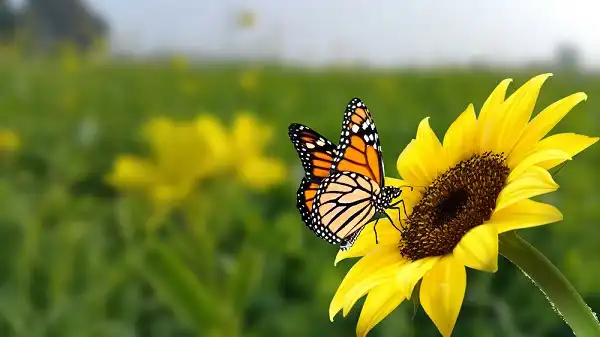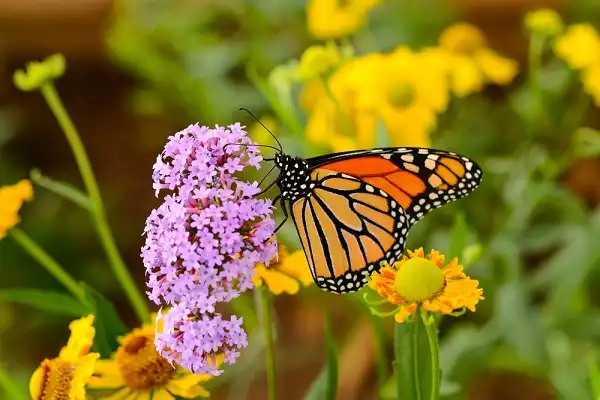The monarch butterfly is a captivating symbol of beauty and grace. Famed for its distinct orange and black wings with white spots, it is one of the most easily recognizable species in North America. The remarkable lifecycle which begins with caterpillar hatching, transitioning into an iconic pupa stage, and emerging as a stunning adult allows these delightful creatures to journey thousands of miles every year during their seasonal migrations. Despite being a beloved part of our North American ecosystem, they are facing alarming population declines due to habitat loss and other threats caused by human activities. In this blog post, we’ll explore why monarch butterflies are so important, discuss what kind of help is needed to keep them from going extinct — from planting milkweed to creating safe corridors — then provide practical tips on how individuals can contribute towards sustaining this marvelous species for generations to come.

Monarch Butterfly Description
The monarch butterfly, scientifically known as Danaus plexippus, is a species of butterfly belonging to the family Nymphalidae. They are famous for their vibrant orange and black wings that boast a striking pattern of veins, lines, and white spots. Interestingly, the female monarch butterfly has thicker veins on its wings compared to the male, which is just one of the many subtle differences between the sexes. Protect monarch butterflies, there are several actions individuals can take to contribute to their conservation efforts. One vital step is to plant milkweed since it is the primary food source for monarch caterpillars.
Monarch Butterfly Habitat
The monarch butterfly habitat spans across North America, from southern Canada to central Mexico. They can be found in a range of habitats, including open fields, meadows, forests, and gardens. However, their survival largely depends on milkweed, which serves as both a breeding ground for the species and the primary food source for monarch caterpillars. Milkweed is a crucial component of the monarch butterfly habitat. Without this plant, the monarch butterfly population will continue to decline rapidly. Unfortunately, milkweed plants are often eradicated due to agricultural practices and urbanization. Furthermore, the use of herbicides and pesticides can wipe out entire fields of milkweed plants, leaving monarch larvae without a food source. Monarch butterfly habitat conservation efforts also involve ensuring the availability of critical overwintering sites. These sites, which represent a small fraction of the butterfly’s overall range, are vital to the species’ survival. Habitat destruction, logging, and tourism disruptions threaten these sites, and the widespread loss of habitat around these sites has dramatic consequences for the population.
Monarch Butterfly Diet
The monarch butterfly’s diet is a critical aspect of its survival and plays an essential role in its life cycle. The monarch butterfly is a herbivorous insect that mainly feeds on milkweed plants, which are vital for the species’ survival. Adult butterflies feed on the nectar of flowers, particularly those that are rich in carbohydrates, such as asters, goldenrods, and thistles. Interestingly, monarch caterpillars are selective in their food choices and prefer some milkweed species over others, depending on the concentration of toxins and other nutrients. For instance, the monarch butterfly population in the eastern United States prefers common milkweed because it has a higher concentration of cardenolides, a toxin that helps protect them from predators. In contrast, western monarchs prefer narrow-leaf milkweed because it has a better nutritional quality, allowing them to develop faster and grow larger.
The monarch butterfly diet is particularly vulnerable to human activities, such as deforestation, urbanization, and the use of pesticides and herbicides. The destruction of milkweed habitats is the primary threat to the species’ survival, as it deprives the caterpillars of their sole food source. The use of chemicals also poses a risk to monarch butterflies, as it not only kills off milkweed plants but also contaminates other plants and flowers that serve as nectar sources for adult butterflies. To ensure the survival of the monarch butterfly, it is crucial to protect their natural habitat and encourage the growth of milkweed plants. Planting milkweed in gardens, parks, and other open spaces can provide critical food sources and breeding grounds for the species.

Monarch Butterfly Size
The monarch butterfly is a medium-sized insect with a wingspan that can reach up to 4 inches in length. While males and females are similar in appearance, females tend to be slightly larger than males. Interestingly, the size of the monarch butterfly can vary based on a variety of factors, including temperature, humidity, and overall environmental conditions. The monarch butterfly undergoes four stages of metamorphosis, each marked by significant changes in size and appearance. During the egg stage, the monarch butterfly larva is less than 1 millimeter in size. Once hatched, the larva begins to feed on milkweed leaves, growing rapidly in size as it molts and sheds its skin multiple times. Overall, the monarch butterfly’s size is a critical aspect of its life cycle, with significant changes occurring in each stage. Protecting their natural habitats and encouraging milkweed growth is essential to ensure the survival of these beautiful and resilient insects. By taking steps to conserve and protect their habitats, we can help ensure that future generations can witness these magnificent creatures and the vital role they play in our ecosystem.
Monarch Butterfly Lifespan
The monarch butterfly has an average lifespan of about four months, although some individuals may live as long as 8 months. During this short period, the monarch butterfly undergoes a remarkable transformation. From egg to larva to pupa to adult, the species goes through four distinct stages of development known as metamorphosis. The lifespan of any particular monarch begins when its eggs are laid on the underside of milkweed leaves. After hatching, the larvae feed voraciously on the plant before entering into a pupal stage and eventually emerging as adults with fully formed wings and bodies. The entire process takes roughly 2 weeks depending on environmental conditions such as temperature and humidity.
Monarch Butterfly Behavior
Monarch butterflies are known for their unique behaviors, many of which are critical to their survival and success as a species. One such behavior is their migration pattern. Each year, millions of monarch butterflies travel from their breeding grounds in Canada and the United States down to their wintering sites in Mexico. This incredible journey spans thousands of miles and takes several generations of monarch butterflies to complete. Monarch butterflies also exhibit unique mating behaviors. Male butterflies use their sensory organs to locate females, often flying long distances to find a suitable mate. After mating, females lay their eggs on milkweed plants, ensuring the survival of the next generation of monarch butterflies. Unfortunately, monarch butterfly populations are under threat from habitat loss, climate change, and pesticide use. It is essential to protect and conserve their natural habitats, as well as encourage the growth of milkweed plants, to ensure the long-term survival of monarch butterflies.

Monarch Butterfly Speed
Monarch butterflies are not only fascinating in their behaviors and life cycle but also in their incredible speed. During migration, these butterflies travel at an average speed of 25 miles per hour. This might seem slow to us, but considering their small size and wing span, it is an impressive feat. Monarch butterflies fly at an altitude of up to 3,000 feet above the ground and cover thousands of miles during their migration from Canada and the United States to their wintering grounds in Mexico. They fly in a wave-like pattern, known as the “Monarch Butterfly Wave,” that can reach up to 10,000 butterflies at a time. Their incredible speed and endurance are not the only factors that make monarch butterflies unique. They also rely on the position of the sun and the Earth’s magnetic field to navigate during their migration, making them one of the few species that use these cues for navigation.
Monarch Butterfly Hunting
Monarch butterfly hunting is not a common activity as these beautiful creatures are mostly known for their migratory patterns, unique behaviors, and critical role in the ecosystem. However, some people do seek out monarchs to capture or hunt them for various reasons, including their distinctive coloration, and for scientific research. While hunting monarch butterflies is legal in some regions under certain circumstances, it is important to note that these insects play a crucial role in the ecosystem as pollinators and as a food source for predators such as birds and other insects.
Hunting them can disrupt their natural habitat and pose a threat to their survival. Additionally, monarch butterflies are poisonous to predators due to the chemicals they consume from milkweed plants during their larval stage. This means that consuming even a small amount of a monarch butterfly can cause sickness or death in predators. Therefore, hunting monarch butterflies for consumption is not a recommended activity. On the other hand, capturing monarch butterflies for scientific research purposes is common. Scientists use monarch specimens to study their migration patterns, genetic makeup, and behavior. They capture these butterflies using nets and release them after collecting the necessary data or taking photographs.
Monarch Butterfly Migration
The most recognizable aspect of monarch butterflies is their incredible migration pattern. Every year, millions of monarchs make a round-trip journey from the northern United and southern Canada to the overwing grounds in and California. Along the way, they stop at various locations to feed, rest, and reproduce. Monarchs use a combination of environmental cues such as the sun’s position and Earth’s magnetic field to navigate during their travels. After spending several months in the overwintering sites, they begin their return trip northward in search of milkweed plants on which they lay eggs for new generations of butterflies. Scientists are still trying to understand how these remarkable creatures manage such an impressive feat each year by studying their migratory patterns and behaviors. This has helped them to develop conservation strategies that can help protect monarchs from further decline in the future.

Conclusion
Monarch butterflies are among the most fascinating creatures on Earth. Not only do they possess incredible speed and endurance for their size, but they also rely on the sun and Earth’s magnetic field to navigate during their travels. Additionally, monarch butterfly larvae move quickly in search of food and shelter. As these incredible insects face threats such as climate change, habitat loss, and pesticide use, it is important that we take action to protect them from further harm. This includes protecting their habitats and conserving their behaviors so that future generations can appreciate the beauty and speed of monarch butterflies. Hunting them should be done with caution and only when absolutely necessary as they play an important role in the ecosystem as pollinators and a food source for predators.
Frequently Asked Question

